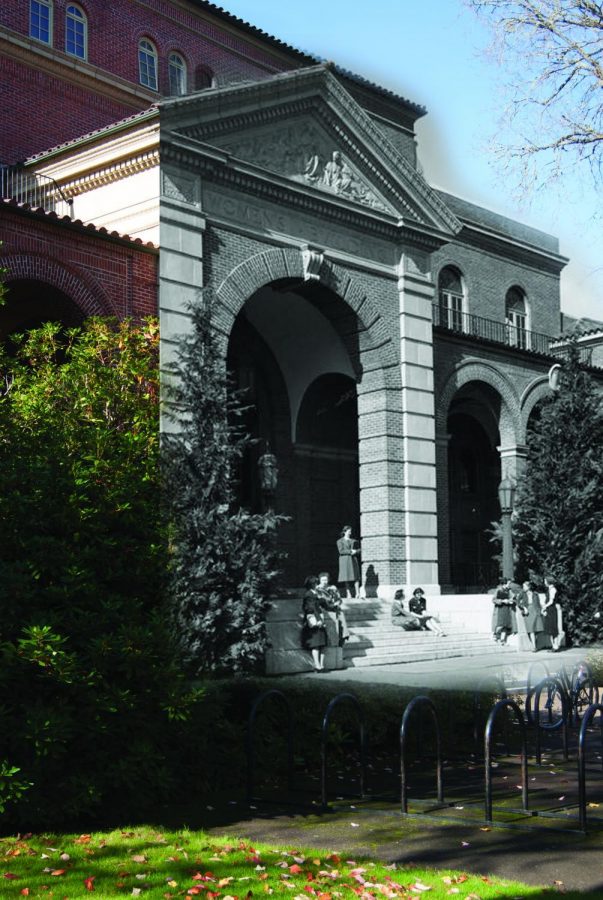OSU’s efforts toward gender inclusion have ‘come a long way’
April 15, 2019
Oregon State University has been around for the last 150 years and in that time, has come a long way with women’s rights, according to the vice president of OSU Cascades campus and an OSU alumnus, Rebecca Johnson.
Through the decades, gender roles and equality at OSU have changed, and remnants of gender-segregation can be seen on campus. Rebecca Johnson, who has a Ph.D in natural resource economics, attended the university in the ‘80s. Johnson witnessed changes in the way the school treated women throughout her time as a student and faculty member at OSU.
“Forestry was and is a male-dominated profession, but there are many more women students and professors in forestry than when I started,” Johnson said. “Professional fields like forestry are still challenged in terms of gender diversity, but the college has made great strides.”
Prior to the passing of Title IX, in 1972, some buildings on campus were segregated based on gender. Title IX states no one in the U.S. will be excluded from participation, denied benefits or be discriminated against under any education program or activity funded by federal money due to gender.
Johnson said during her time at OSU, men and women’s athletics were not treated equally. Typically, the women’s teams were not allowed to use the same facilities as the men.
“We didn’t have the same training facilities, and the coaches were certainly not paid anywhere close to what the men’s coaches were paid,” Johnson, who played basketball and golf, said. “We traveled in vans while the men flew to their competitions. But Title IX changed most of that.”
According to the Women’s Words and Womens Work Archives, from 1926 to about the ‘70s, the Women’s Building was used for women’s athletic classes whereas Langton Hall held men’s.
Sylvia Moore was a graduate student at OSU in the ‘60s. She stated in an oral history interview for the Voices of OSU Women Archive that she received her degree in physical education in order to participate in competitive athletics. Moore added at the time men and women’s physical education were separate departments.
“I think I was on campus for 3 years before I ever went over to Langton. And it was another 3 years before they merged men’s PE and women’s PE,” Moore stated in her oral interview.
After completing her graduate degree at OSU, Moore became the first female athletic director at the university in the ‘80s and was the first gymnastics coach of the modern era of OSU. Although Moore left the athletic department in 1986, she said she witnessed the first steps toward gender inclusivity in athletics at OSU.
According to Tiah Edmunson-Morton, OSU’s archivist and curator, women were never formally restricted from any campus location besides residence halls and recreational facilities. However, though not all buildings were gender specific, women were often directed to “acceptable” places to gather and learn.
Edmunson-Morton said some of these sexist norms may have carried over into the present.
“This is by no means generalizable, but I assume that many would still feel like they weren’t welcomed in some spaces that feel male-dominated,” Edmunson-Morton said. “For example, gender-lopsided classes and the weights area at Dixon.”
Edmunson-Morton said several buildings at OSU served specifically as women’s spaces. These buildings included Snell Hall, now known as Ballard Hall, Waldo Hall, Milam Hall, the Women’s Building and the The Hattie Redmond Women and Gender Center.
Waldo Hall was built as a women’s dorm in 1909 for students and housed some female faculty. Waldo also served as the Domestic Science program’s former lab space. Cooking, home nursing, laundry and proper etiquette were also taught in Waldo hall, as stated in the OSU Women’s Words and Women’s Work Archive.
Historically, the requirements for men and women in education were not the same. According to the 1926 -1927 General Catalog for OSU, physical education was required for all students during their freshman and sophomore years. However, it was required for women to take an extra two years of physical education, unless they were excused by recommendation from the Professor of Physical Education for Women.
The Women’s Building held all female physical education classes and was used as a practice facility for female athletics.
“As you enter that building, notice the steps are very wide and very shallow, and that was so women could be very ladylike in climbing the steps to the lobby,” Moore stated in her oral history interview.
Prior to the construction of Austin Hall and the Learning Innovation Center, the area was known as the Women’s Building Field. This is where women practiced outdoor activities.
Throughout history, the purpose of many buildings around the OSU campus has changed. Many hold their own historical stories and have evolved to serve all genders.
“There’s no question that women’s rights have come a long way from when I started my career in the College of Forestry in 1984,” Johnson said.











































































































